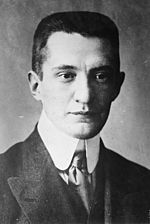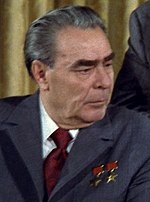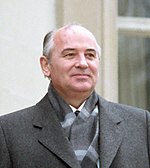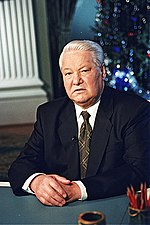Bald–hairy
Bald – hairy is a common joke in Russian political discourse, referring to the empirical rule of the state leaders' succession defined as a change of a bald leader with a hairy one and vice versa. This consistent pattern can be traced back until as early as 1825, when Nicholas I succeeded his late brother Alexander as the Russian Emperor. Nicholas I's son Alexander II formed the first "bald – hairy" pair of the sequence with his father. The current "bald – hairy" pair of Russian rulers are Prime Minister (former President) Vladimir Putin and incumbent President Dmitry Medvedev.
Pattern
The point of the joke is that there is a strict rule applying to Russia's political life for the latest two centuries. A bald (or obviously balding) state leader is supposed to be succeeded by a non-bald ("hairy") one, and vice versa. Whilst this pattern is most likely a coincidence, it has been holding true since 1825, starting from Nicholas I.[1]
| Bald leaders | Portrait | Hairy leaders | Portrait |
|---|---|---|---|
| Nicholas I (1825—1855) |

|
Alexander II (1855—1881) |

|
| Alexander III (1881—1894) |

|
Nicholas II (1894—1917) |

|
| Georgy Lvov (1917) |

|
Alexander Kerensky (1917) |

|
| Vladimir Lenin (1917—1924) |
File:Lenin CL.jpg | Joseph Stalin (1924—1953) |

|
| Nikita Khrushchev (1953—1964) |

|
Leonid Brezhnev (1964—1982) |

|
| Yuri Andropov (1982—1984) |

|
Konstantin Chernenko (1984—1985) |
File:Konstantin Chernenko.jpg |
| Mikhail Gorbachev (1985—1991) |

|
Boris Yeltsin (1991—1999) |

|
| Vladimir Putin (2000—2008) |

|
Dmitry Medvedev (since 2008) |

|
Usage
The pattern is believed to become well-known during the period of Leonid Brezhnev's leadership. In the middle of the 1990s some humorously predicted that bald Gennadiy Zyuganov would "inevitably" win 1996 presidential election and thus replace non-bald Boris Yeltsin. In modern Russia the pattern is a frequent subject for jokes and cartoons.[2] It is often used in political journalism:
“Bald, hairy, bald, hairy, bald, hairy - that's how we elect our leaders,” my St Petersburg friend quips when I ask if she voted in the presidential elections. “Think about it: Lenin was bald, Stalin was hairy; Kruschev was bald, Brezhnev was hairy; Gorbachev was bald, Yeltsin was hairy - and Putin is practically bald. Medvedev had to win.”[3]
Other patterns of Russian rulers succession
From 1682 to 1801 there was a strict "man – woman" sequence on the Russian throne: Peter I the Great, Catherine I, Peter II, Anna of Russia, Ivan VI, Elizabeth of Russia, Peter III, Catherine II the Great, Paul I of Russia. Emperor Paul changed the rules of succession to the throne so that only men could rule the country, and the "man – woman" interchange was terminated. If Tsarina Sophia (a sister of Peter I and Ivan V and a powerful regent during their minority), is counted as a de facto ruler, then the sequence could be traced from 1676, when another of Sophia's brothers, Feodor III, succeeded to the throne.[1]
Sources
- Vladimir Savchenko. Новая наука Историоматика/Пси-гидродинамика Советской власти, или Закон «лысых/волосатых» (in Russian).
- Y. Mikhailina (2007-01-12). "Преемник должен быть без запаха. Интервью И. Минтусова, личного консультанта Б. Ельцина" (in Russian). Moskovskiy Komsomolets.
- V. Kupriyanov. Башмак Эмпедокла (in Russian).
- V. Tseplyaev. "Мистические закономерности российской власти" (in Russian). AiF online.
{{cite web}}: Unknown parameter|link=ignored (help) - Alla Bossart. "С Новым гоном!" (in Russian). Gazeta.ru.
- D. Dybov (2002-10-08). "Не дай Буш!" (in Russian). Moskovskie Novosti.
- V. Skachko (April 11 to 17 2008). "Мистика и власть" (in Russian). Kievskiy Telegraf.
{{cite web}}: Check date values in:|date=(help) - "Шарж в газете, пуля во лбу" (in Russian).
References
- ^ a b V. Skachko (April 11 to 17 2008). "Мистика и власть" (in Russian). Kievskiy Telegraf.
{{cite web}}: Check date values in:|date=(help) - ^ "Череда правителей России (закономерность истории): Александр II — лысый Николай … Анекдоты из России" (in Russian). 24 April 2004.
- ^ Catriona Bass (7 March 2008). "Russian politics: the bald truth".
{{cite news}}: Unknown parameter|source=ignored (help)
